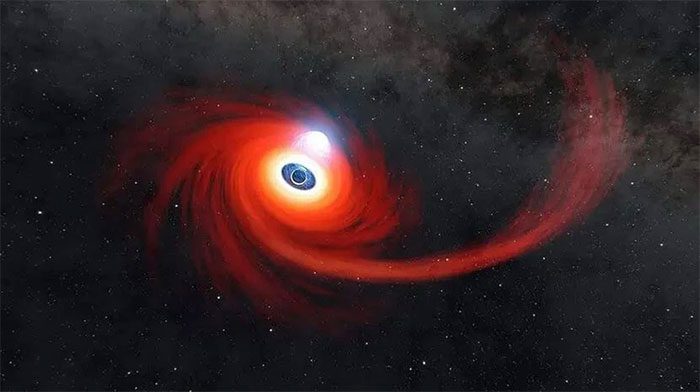Astronomers have for the first time determined the rotation speed of a black hole.
The new method, detailed in a paper published in the journal Nature, is based on observing the “wobble” of stellar debris left behind after being consumed by the black hole.
Black hole tidal disruption events (TDEs) are massive moments when a black hole exerts its gravitational influence on stars, tearing them apart. As a result, part of the star is blown away, while the remainder forms a hot accretion disk, containing stellar material that orbits the black hole. The team of astronomers demonstrated that the “wobble” of this disk is key to determining the rotation speed of the black hole.

Black hole rotating at less than 25% the speed of light.
The black hole studied is located at the center of the SDSS J135353.80+535949.7 galaxy, which is relatively quiet and approximately one billion light-years away from Earth. The authors estimate that this black hole has a mass about 700,000 times that of our Sun. In 2020, NASA’s NICER (Neutron star Interior Composition Explorer) instrument aboard the International Space Station (ISS) analyzed an X-ray flare from this galaxy, designated AT2020ocn. After monitoring the X-ray flares for several months, astronomers realized that this X-ray was produced shortly after a star was disrupted by the black hole.
They measured the wobble of the accretion disk as it was pulled and pushed by the rotating black hole.
Analysis revealed that the black hole is rotating at less than 25% the speed of light – relatively slow for a black hole. This new method of measuring black hole rotation speed could help determine the rotation rates of hundreds of black holes near us.
Dheeraj “DJ” Pasham, the lead author of the study from the Massachusetts Institute of Technology (MIT), stated: “By studying several systems in the coming years with this method, astronomers can estimate the overall distribution of black hole rotation speeds and understand the age-old question of how black holes evolve over time.”
This is the first time that the wobble of the accretion disk has been used to determine the rotation speed of a black hole. Author Pasham noted that new instruments – such as the Rubin Observatory currently under construction in Chile – will aid in such measurements.
The astronomer further added: “The rotation speed of a supermassive black hole tells you about the history of that black hole. Even if only a small fraction of the black holes that Rubin records have signals like this, we now have a way to measure the rotation speeds of hundreds of TDEs. Then we can make significant statements about how black holes evolve throughout the lifespan of the universe.”




















































